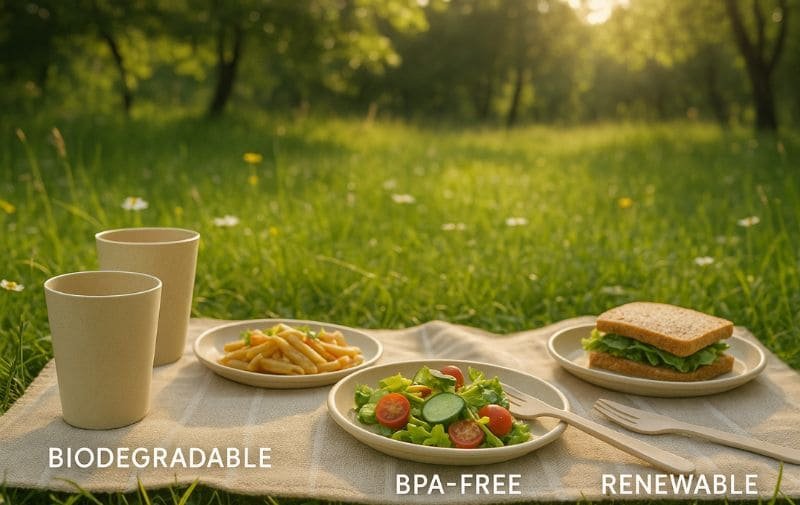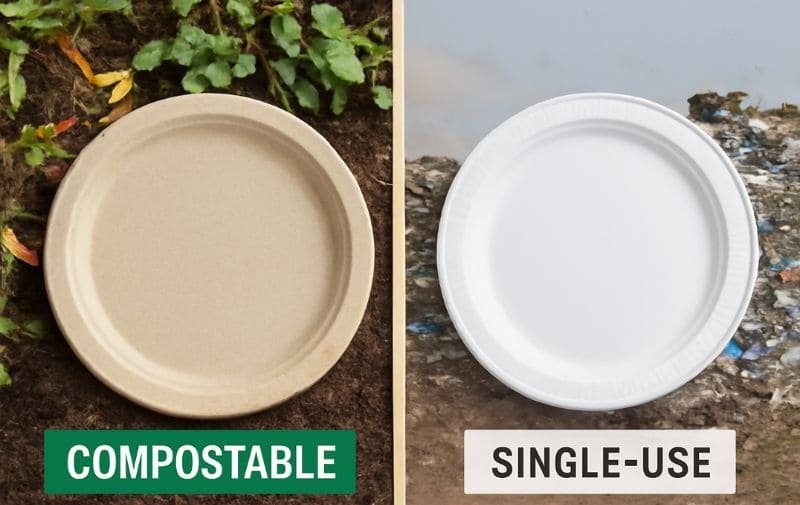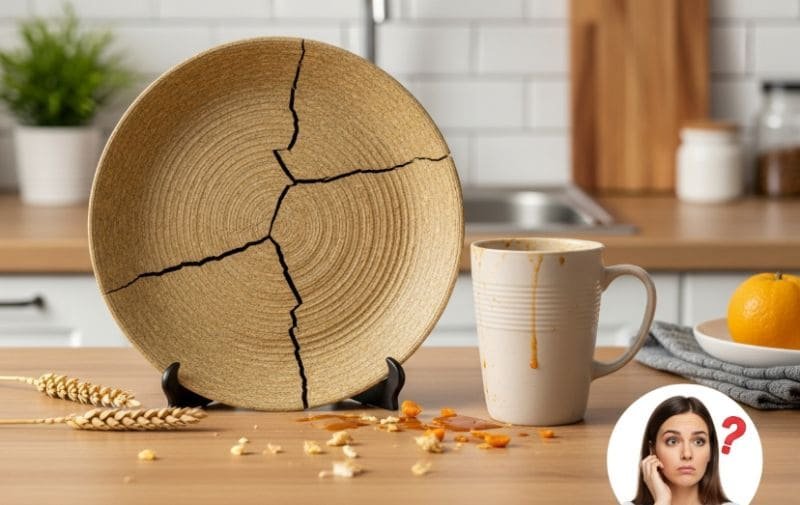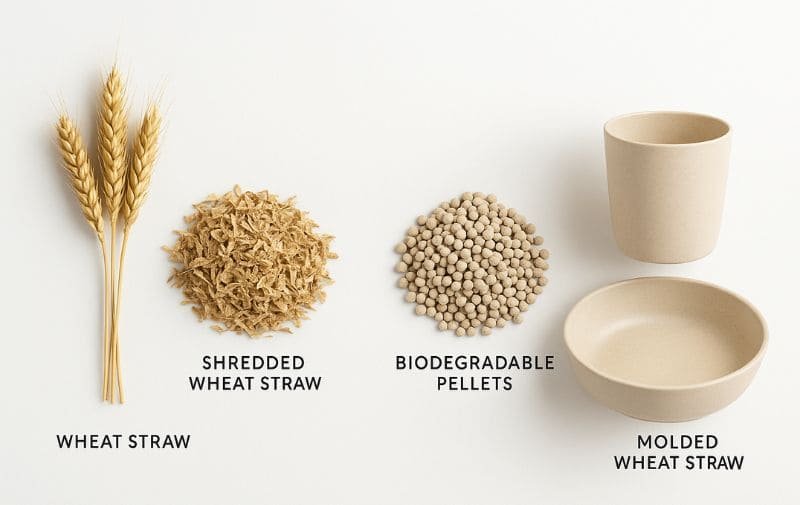You’re trying to make a sustainable choice. You see beautiful, earthy-looking dinnerware labeled “Wheat Straw,” and it seems like the perfect solution—natural, unbreakable, and eco-friendly. But a part of you wonders if it’s too good to be true. What is it really made of?
Wheat straw dinnerware is a composite material made by mixing natural wheat straw fibers (typically 30-50%) with a plastic binder—usually food-grade Polypropylene (PP). While it reduces plastic use and utilizes agricultural waste, it is not biodegradable and its performance depends entirely on its plastic component.
The story of wheat straw is more complex than a simple “eco-friendly” label suggests. As someone who has sourced and evaluated these products for years, I’ve seen the confusion firsthand. It’s a fantastic material in many ways, but you need to understand what it is—and what it isn’t—to make an informed decision. Let’s break down the science, the performance, and the real environmental impact.
Last Updated: July 24th. 2025 | Estimated Reading Time: 12 Minutes
Let’s Be Clear: What is Wheat Straw Dinnerware Really Made Of?
The most common misconception is that this tableware is made from 100% natural wheat. That’s not the case. It’s a clever blend of natural and man-made materials.
Wheat straw dinnerware is a composite. It uses reclaimed wheat straw fibers for bulk and texture, but relies on a plastic binder like Polypropylene (PP) to make it durable, waterproof, and usable as a plate or bowl.
You can’t just press straw into the shape of a plate; it wouldn’t hold liquid or survive a single wash. It needs a binding agent to hold the fibers together. The final product is essentially a plastic plate with a high percentage of natural filler.
The Anatomy of a Wheat Straw Plate
| Component | Role in the Final Product | Typical Percentage |
|---|---|---|
| Wheat Straw Fiber | Provides structure, reduces plastic content, and creates the signature speckled, matte look. | 30% – 50% |
| Plastic Binder (PP) | Makes the product waterproof, durable, heat-resistant, and microwave-safe. Acts as the “glue.” | 50% – 70% |
| Colorants & Additives | Provides color and can enhance stability. | < 1% |
Insider Insight: Understanding this formula is the key to everything else. The wheat straw provides the eco-story and the aesthetic, but the plastic binder dictates most of the product’s real-world performance.
Why Does It Have That Unique Look and Feel?
If it’s mostly plastic, why doesn’t it just feel like a regular plastic plate? This is where the magic of the composite material comes in.
The appeal of wheat straw dinnerware comes from its unique aesthetic and tactile feel. The inclusion of natural fibers gives it a distinctive matte texture with visible organic specks, making it feel less artificial than pure plastic.
When you hold a wheat straw plate, you notice the difference immediately. It’s not the smooth, uniform surface of melamine or a standard PP plate. Instead, you see and feel the tiny particles of straw suspended within the material. This creates an earthy, organic impression that resonates with consumers looking for natural products.
I remember the first time I handled a set. It was surprisingly lightweight compared to ceramic, yet it felt sturdy and substantial in my hands. The subtle, oat-like scent of the new product and the matte finish were instantly appealing. This unique sensory experience is one of its biggest selling points and a primary reason it has become so popular for casual dining, kids’ tableware, and outdoor use.
Pro Tip: This unique feel makes it a great “bridge” product. It offers a more premium and natural-feeling experience than basic plastic plates, without the weight and breakability of ceramic.

From Farm Field to Table: The Production Journey
The manufacturing process begins with an agricultural byproduct that would otherwise go to waste.
- Harvesting Waste: After grain is harvested, the leftover stalks (wheat straw) are collected. Traditionally, this waste might be burned, releasing carbon into the atmosphere.
- Processing Fiber: The straw is cleaned and broken down to create a fine, fibrous pulp.
- Compounding: This natural pulp is then mixed with the chosen polymer binder (PP or PLA) and other additives to form granular pellets. This is the new raw material.
- Molding: These pellets are heated and injection-molded into the final shapes of plates, bowls, and cups—a process very similar to manufacturing standard plastic products.
How Does Wheat Straw Perform in Real Life?
Looks are one thing, but how does it hold up to daily use? Can it handle the microwave, the dishwasher, and messy foods?
Because it typically uses a Polypropylene (PP) binder, wheat straw dinnerware is generally microwave and dishwasher safe. However, its primary performance weakness is its susceptibility to staining from strongly pigmented foods.
Let’s break down its performance characteristics, which are directly tied to that PP binder.
- Microwave Safety: This is its biggest advantage over melamine. Since Polypropylene (#5 plastic) is a microwave-safe material with a high heat tolerance, you can safely reheat food on wheat straw plates and bowls.
- Dishwasher Safety: It’s designed for modern convenience and holds up well to repeated washing in a standard home dishwasher.
- Durability: It’s shatter-proof. Drop a wheat straw plate, and it will bounce, not break. This makes it an outstanding choice for families with young children, for picnics, camping, or any environment where ceramic is too risky.
- Stain Resistance: This is its main drawback. I’ve seen firsthand how a plate used for spaghetti bolognese or a bowl for a curry can develop a faint orange or yellow tinge over time. The porous nature of the composite material makes it more likely to absorb pigments compared to high-grade, non-porous A5 melamine.
How Eco-Friendly Is It, Really?
This is the most important question, and the answer is nuanced. It’s a step in the right direction, but it’s not a perfect environmental solution.
Wheat straw dinnerware is “eco-friendlier,” not perfectly “eco-friendly.” Its main benefits are using agricultural waste and reducing the amount of virgin plastic required. However, PP-based versions are not biodegradable and must be disposed of like any other plastic.
Let’s separate the genuine benefits from the marketing hype.
The Good:
- Uses Agricultural Waste: It creates value from wheat straw, a byproduct of the grain harvest that might otherwise be burned, releasing carbon into the atmosphere.
- Reduces Plastic Consumption: By replacing 30-50% of the material with natural fiber, it requires less fossil-fuel-based virgin plastic to produce each plate. This is a clear win for resource conservation.
The Reality of “Biodegradable”:
This is where you need to be careful. The term “biodegradable” is often misused.
- If the binder is Polypropylene (PP): The product is NOT biodegradable. The wheat fibers may break down over centuries, but the PP plastic binder will persist in the environment for hundreds of years, just like a regular plastic bottle cap.
- If the binder is Polylactic Acid (PLA): PLA is a bioplastic derived from plant starches. A PLA-based wheat straw product can be commercially compostable. This means it will break down into organic matter, but only in a high-temperature industrial composting facility. It will not biodegrade in your backyard compost bin or in a landfill.
Since the vast majority of wheat straw dinnerware uses durable, heat-resistant, and cost-effective PP, you should assume it is not biodegradable unless explicitly stated and certified otherwise.
| Binder Material | Is It Biodegradable? | What Really Happens to It? |
|---|---|---|
| Polypropylene (PP) | No | It is a conventional plastic. It is not biodegradable or compostable. It will persist in a landfill for hundreds of years, just like any other plastic item. Its primary eco-benefit is the reduction in plastic used, not its end-of-life. |
| Polylactic Acid (PLA) | Only in a commercial facility | It is a bioplastic that is commercially compostable. It will not biodegrade in your backyard compost bin or in a landfill. It requires the high heat and specific conditions of an industrial composting facility, which are not widely available to consumers. |
Pro Tip: Assume any wheat straw product you buy is made with a PP binder unless it is explicitly certified as “Commercially Compostable” (which indicates a PLA binder). The PP-based version is far more common due to its durability and lower cost.

Wheat Straw vs. The Competition: A Head-to-Head Comparison
So where does wheat straw fit in the broader market of tableware? Seeing it side-by-side with its competitors makes its unique position clear.
Wheat straw dinnerware occupies a middle ground, offering the microwave safety of plastic and a better eco-story, but without the premium feel of ceramic or the stain resistance of melamine.
Tableware Head-to-Head Comparison:
| Feature | Wheat Straw Dinnerware | A5 Melamine | Polypropylene (PP) | Ceramic |
|---|---|---|---|---|
| Key Composition | Wheat Fiber + PP Binder | 100% Melamine Resin | 100% Polypropylene | Clay / Porcelain |
| Microwave-Safe | ✅ Yes | ❌ NO | ✅ Yes | ✅ Yes |
| Break-Resistant | ✅ Yes | ✅ Yes | ✅ Yes | ❌ No |
| Stain Resistance | Fair | Excellent | Good | Excellent |
| Eco-Claim | Reduces plastic use | None | Recyclable (#5) | Natural material |
| Aesthetics | Earthy, Matte, Speckled | Glossy, Ceramic-like | Basic, Functional | Premium, Heavy |
| Relative Price | Low-Medium | Medium | Low | Medium-High |
The Value Proposition: Where Does it Fit in the Market?
Wheat straw dinnerware has cleverly positioned itself in a “sweet spot” in the market, bridging the gap between basic plastic and traditional ceramic.
- It’s an aesthetic and eco-story upgrade from cheap, purely functional PP plastic plates.
- It’s a more durable, lightweight, and often less expensive alternative to fragile ceramic, making it perfect for families.
- Its key advantage over melamine is being microwave-safe, though it can’t achieve the same high-gloss, premium finishes.
What Should You Ask Before Buying Wheat Straw Dinnerware?
If you’re considering sourcing this material for your business or buying a set for your home, you need to ask the right questions to cut through the greenwashing.
To truly understand a wheat straw product, you must ask your supplier two critical questions: “What is the specific binder material?” and “What is the exact percentage of wheat straw fiber?”

Don’t just accept the “eco-friendly” label at face value. Empower yourself by being a knowledgeable buyer.
- “What is the specific binder material – Polypropylene (PP) or PLA?”
- Why it matters: This is the most important question. The answer tells you if the product is microwave-safe (PP = yes, PLA = sometimes, with lower heat tolerance) and what its true end-of-life is (PP = landfill/recycling, PLA = industrial composting).
- Why it matters: This is the most important question. The answer tells you if the product is microwave-safe (PP = yes, PLA = sometimes, with lower heat tolerance) and what its true end-of-life is (PP = landfill/recycling, PLA = industrial composting).
- “What is the exact percentage of wheat straw fiber?”
- Why it matters: This tells you how much plastic is actually being replaced. A product with 50% fiber has a much stronger eco-story than one with only 20%. Higher fiber content also contributes more to the unique matte aesthetic.
- Why it matters: This tells you how much plastic is actually being replaced. A product with 50% fiber has a much stronger eco-story than one with only 20%. Higher fiber content also contributes more to the unique matte aesthetic.
- “Can you provide food-grade safety certifications?”
- Why it matters: Always demand proof of safety testing, such as LFGB or FDA compliance. This ensures that the final composite material, including the binders and colorants, is free from harmful chemicals and safe for food contact.
- Why it matters: Always demand proof of safety testing, such as LFGB or FDA compliance. This ensures that the final composite material, including the binders and colorants, is free from harmful chemicals and safe for food contact.
Conclusion: A Great Choice, When You Know What It Is
Wheat straw dinnerware is a fantastic, affordable, and durable option for families and anyone seeking a lightweight, unbreakable plate with a natural aesthetic. Its key advantage is being microwave-safe, setting it apart from melamine. While its eco-claims need context, it represents a positive step in reducing plastic consumption.
Frequently Asked Questions (F.A.Q.)
1. Let’s be direct: Is wheat straw dinnerware just plastic with some straw mixed in?
Yes, that is the most accurate way to describe it. It’s a composite material where natural wheat straw fibers (the filler) are bound together by a plastic polymer, most commonly Polypropylene (PP). This combination gives it durability and water resistance while reducing the total amount of plastic needed.
2. Is wheat straw dinnerware truly biodegradable? I see that claim everywhere.
Almost certainly not. If the binder is Polypropylene (PP)—which it is in the vast majority of products—it is not biodegradable. It will break down into smaller plastic particles over time but will not return to nature. Only the rare versions made with a PLA binder are “commercially compostable,” meaning they require a special industrial facility to biodegrade, not your home compost pile.
3. Is it completely safe for my kids to use?
Yes, provided you buy from a reputable source. Certified wheat straw dinnerware is non-toxic, BPA-free, and must pass food-grade safety standards like FDA or LFGB. Its lightweight and shatterproof nature makes it physically safer for children than heavy, breakable ceramic plates.
4. How can I remove tough stains like tomato sauce from my wheat straw plates?
For tough stains, immediately rinse the plate after use. For set-in stains, create a paste of baking soda and a little water. Apply it to the stained area, let it sit for 15-20 minutes, and then gently scrub with a non-abrasive sponge before washing as usual. Avoid using harsh scouring pads which can scratch the surface.
5. Which is a better choice for my family: wheat straw or melamine dinnerware?
It depends on your top priority. If being able to reheat food in the microwave is essential, then wheat straw is the clear winner, as melamine must never be microwaved. If your priority is maximum durability and stain resistance with a more ceramic-like look and feel, then high-quality A5 melamine is the superior choice.
6. Does wheat straw dinnerware absorb odors or flavors from food?
Generally, it has good resistance to odors. However, like any plastic-based product, if very strong-smelling foods (like garlic-heavy sauces or curries) are left sitting in it for extended periods, some faint odor may be retained. Regular washing in a dishwasher is typically effective at preventing this.
Recommended
- Microwave-Safe Tableware: The Ultimate Guide
- Wikipedia: Polypropylene (PP Plastic)
- Wikipedia: Bioplastic & Polylactic Acid (PLA)
- FDA: Food Contact Substance Notification Program



